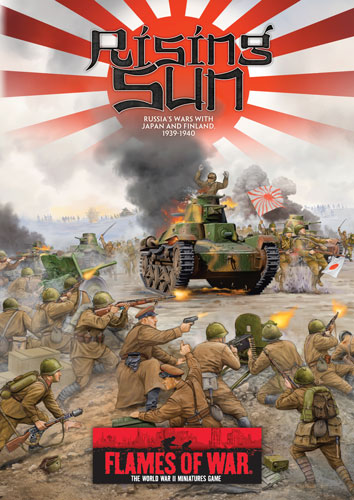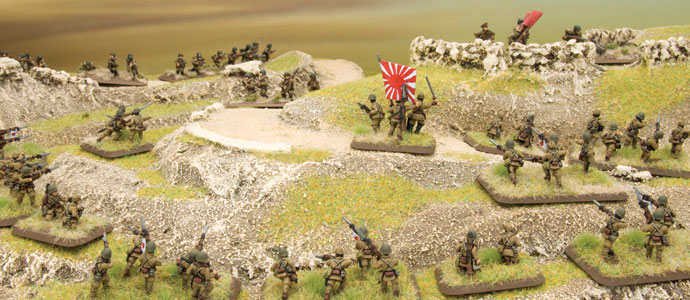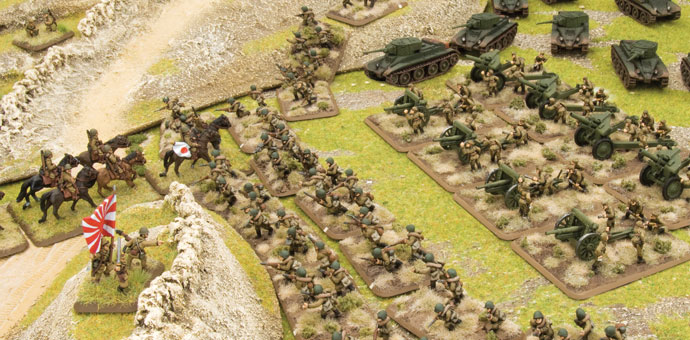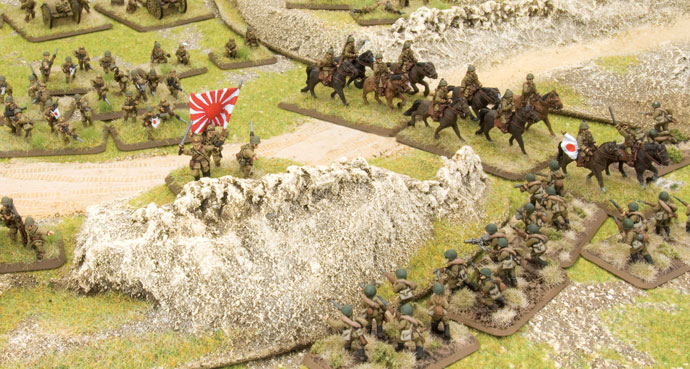|
|
 |
|
|
An Incident At Lake Khasan
 |
An Incident At Lake Khasan
with Wayne Turner
Between May and September 1939 the Soviets fought an undeclared border war with Japanese forces in Manchuria, which would become known as the Battles of Khalkhin Gol or the Nomonhan Incident. However, this clash had been preceded by another battle in 1938 around Lake Khasan, also known as the Changkufeng Incident. The Lake Khasan battles arose from a disagreement over the demarcation of the boundary between the Soviet Union and Japanese-controlled Manchuria near the Korean border. The Japanese claimed that the demarcation markers had been tampered with.
Learn more about refighting the Battles of Lake Khasan using Rising Sun here...
|
In July 1938 the Soviets began to occupy the high ground west of Lake Khasan, most notably the disputed Bezymyannaya (Chinese name: Shachaofeng) and Zaozernaya (Chinese name: Changkufeng) Hills. The heights overlooked the Korean port-city of Rajin, as well as strategic railways linking Korea to Manchuria. The Soviets slowly built up the number troops on the Changkufeng Heights, building fortifications and making themselves at home.
The Japanese commanders on the ground took the matter to Tokyo, recommending that a formal protest be sent to the USSR. The Japanese attaché in Moscow demanded the removal of Soviet border troops from the heights, claiming this territory by the Soviet–Korea border was Korean (so by default Japanese). The demand was rejected by the Soviets.
|
 |
The Japanese launched their first attack on 29 July 1938. It was
repelled, but the Japanese kept up the pressure and on 31 July the
Soviet troops were forced to retreat. The Japanese 19th Division along
with some Manchukuo (the renamed Japanese controlled Manchurian state)
units engaged the Soviets. The Japanese 75th Infantry Regiment expelled
troops of the Soviet 39th Rifle Corps from the hill in a night sortie,
the execution of which became a Japanese model for assaults on fortified
positions. Fighting for the high ground continued backwards and
forwards.
On 31 July the Soviets mobilised the 1st Coastal Army
and the Pacific Fleet. Additional Soviet forces were moved to the Lake
Khasan area. Fighting heated up between 2 and 9 August and the Japanese
forces were decisively defeated and thrown out of the Soviet territory.
After negotiations, and though tensions remained high, hostilities
halted on 11 August 1938. During the fighting 717 Soviet troops were
killed, 75 were missing, and 2,752 were wounded. On the Japanese and
Manchukuo side, 526 were killed and 916 were wounded. |
 |
Japanese 19th Division
The 19th Division was raised in 1915 as a garrison force for Korea and was stationed in far northeast Korea. In 1931 the 19th Division was called on to take part in the invasion of Manchuria, during which time it occupied Changchun and Harbin. It continued to be stationed in Manchuria afterwards.
In July 1938, it was the main Japanese combat division at the Battle of Lake Khasan. It was organised as a square division with four infantry regiments consisting of the 73rd, 74th, 75th, and 76th Infantry Regiments. It also included Engineer, Artillery and Cavalry regiments. Afterwards, it was recalled to the Korean border.
Afterwards the Lake Khasan battles, it was redeployed to the Korean border. In December 1944, the 19th Division was transferred to the Japanese Fourteenth Army in the Philippines. It was destroyed while fighting the US and Allied Philippine Commonwealth troops during the Battle of Luzon.
Night Attack by the 75th Infantry Regiment
On
the early morning hours of 31 July 1938 the 1st Battalion, 75th
Infantry Regiment launched a night attack against Soviet troops
occupying a 150 metre high ridgeline along the Changkufeng Hill. The
attack by night reduced the reaction time of the Soviets, and the
Japanese were able to engage them in hand-to-hand combat. After a savage
battle with bayonet, grenades and short range fire the Soviet fled in
disorder. This decisive encounter was regarded by Japanese tacticians as
a brilliant example of a night attack, and helped solidify night
attacks as an important Japanese tactic. However, Soviet counter-attacks
by the 32nd and 40th Rifle Divisions, supported by tanks from the 2nd
Mechanised Brigade, threw the Japanese off the hill in August.
|
 |
Soviet 32nd Rifle Division
The 32nd Rifle Division was one of the oldest divisions in the Soviet Army. It had been formed around the Petrograd Workers Regiment, which had been formed in 1917. It served throughout the Russian Civil War, but made its name fighting the Japanese at Lake Khasan, where it was awarded the ‘Order of the Red Banner’. It fought throughout the Great Patriotic War (WWII), eventually being promoted to Guard status as the 29th Guards Rifle Division in May 1942. It finished the war mopping up retreating German forces in Lithuania in 1945. At Lake Khasan the division consisted of the 94th, 95th, and 96th Rifle Regiments, 32nd Artillery Regiment, and the 32nd Separate Tank Battalion.
Soviet 40th Rifle Division
The 40th Rifle Division was formed in western Siberia in the 1920s. The 40th Rifle Division fought alongside the 32nd Rifle Division at Lake Khasan where it occupied the Changkufeng Hill to the south of the Shachaofeng Hill where it held off attacks from the Japanese 19th Division. Unlike the 32nd, the 40th Rifle Division did not fight in the west in 1941, but instead remained in the far east covering Vladivostok. In 1945 the division smashed through the Japanese fortifications at Tungning on the Manchurian border before advancing to the Korean border to cut Japanese communications between Manchuria and Korea.
At Lake Khasan the division consisted of the 20th, 118th, and 119th Rifle Regiments, 40th Artillery Regiment, and 40th Separate Tank Battalion.
|
 |
Soviet Tanks at Lake Khasan
The first military operation of Red Army T-26 light tanks was the Battle of Lake Khasan. The 2nd Mechanised Brigade, the 32nd Separate Tank Battalion, and the 40th Separate Tank Battalion. These included 257 T-26 tanks (with 10 KhT-26 flame-throwing tanks), 3 ST-26 bridgelaying tanks, 81 BT-7 light tanks, and 13 SU-5-2 self-propelled guns (based on a T-26 hull mounting a 122mm obr 1910/30 howitzer).
The 2nd Mechanized Brigade had a completely new command staff as its previous command had been arrested
as ‘enemies of the nation’ three days before heading to Lake Khasan as part of Stalin’s purges. As a consequence the brigades performance was somewhat poor while the new command got to grips with their new roles. During the assault of the Japanese-held Shachaofeng (Bezymyannaya) and Changkufeng (Zaozernaya) hills in August the Soviet tanks met a well-organised Japanese anti-tank defence. 76 T-26 tanks were damaged and 9 destroyed during the Soviet offensive. A number of lessons were learned that led to the development of the T-26 1939 model, including adding sloped armoured to the hull front.
~ Wayne.
|
Last Updated On Thursday, May 8, 2014 by Blake at Battlefront
|
|
|